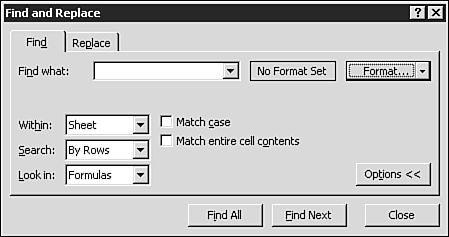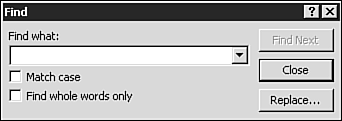Finding and Replacing Text
When you want to find or replace a piece of text in an Office document, the method varies depending on which application you use to find a particular text string, do the following:
Choose Edit, Find. Type the text you want to locate in the Find What box. Word's (and Outlook's) Find and Replace dialog box is shown in Figure 4.5.
Figure 4.5. Word and Outlook have the most comprehensive Find and Replace options.

Set up the parameters, known as criteria, for your search. Depending on which Office application you are using, the process of setting up your search criteria will vary:
In Outlook, Word, or FrontPage, you can choose whether you want to search Up (toward the beginning of the document) or Down (toward the end). In Access, you can choose Up or Down as well, but to do so you must click the More button in the dialog box. In Excel (see Figure 4.6) or PowerPoint, you have no choice as to direction—the first Find uncovers the first occurrence of the string; subsequent Find Next selections move to later occurrences. The Search All option in Access also finds the first occurrence, the same as an Excel or PowerPoint Find.
Figure 4.6. Excel's Find and Replace is remarkably different from Word's.

Excel enables you to choose whether you want to search row-major ("Search By Rows" going across the current row before dropping down to the next one) or column-major ("Search By Columns" going down the current column before looking at the next one to the right). Make your choice in the Search box. Excel also enables you to look at formulas or values (that is, formula results). If you have a cell that contains the formula =SUM(A1:B3), for example, searching the formulas for B3 results in a hit, whereas searching the values doesn't.
Note
Excel enables you to easily search for text in comments. This feature can come in handy if you're scanning for comments from a specific individual or those that apply to a given topic. To do so, select Comments in the Look In box.
All the Office applications enable you to specify that you want to Match Case (the accelerator key varies from application to application, see Figure 4.7). With this box checked, the capitalization shown in the Find What text box must match the capitalization of the text in the document precisely to get a "hit".
Figure 4.7. PowerPoint's Spartan Find dialog box is limited.

Outlook, Word, FrontPage, and PowerPoint enable you to restrict the search to Find Whole Words Only, by checking a box. In that situation, the text in the Find What field must appear in the document preceded and followed by a space or punctuation mark: beast, for example, will match beast but not beasts. Excel has a comparable check box that limits hits to cells where the entire cell contents matches the text in the Find What box. Similarly, Access can limit hits to those that match the entire field.
Outlook, Word, Excel, and Access accept wildcards:
* matches one or more letters. For example, s*ap will turn up hits on snap or strap, but not on sap.
? matches one single letter. For example, b?t will match bit or bat, but not boot.
In Excel only, the tilde character (~) followed by a ~, ?, or * matches ~, ?, or *. So hop~* matches hop*, but not hop? or hope, and tr~?p matches tr?p but not tr*p or tr~p or trip.
Word has an enormous number of additional search features; the other Office applications pale in comparison.
→ To learn more about Word's powerful search features, see "Finding and Replacing Text and Other Parts of a Document".
